When it comes to our increasingly digitally connected world, communication platforms such as Zoho Cliq and Slack have become absolutely indispensable tools for any business that wants to improve teamwork and streamline workflows. Both platforms offer a suite of features, each designed to foster collaboration, but they are unique in their approaches and offerings. Let’s take a look at each platform so you can better decide which suits your business needs the best.

Zoho Cliq is a business messaging tool that is part of the broader Zoho family of apps and can integrate seamlessly with other Zoho services. One of Cliq's most notable advantages is its operation within that larger ecosystem, making it a great choice for businesses already using other Zoho apps.
Other benefits include a fairly intuitive user interface emphasizing organized conversations that are easy to reach, scroll through, and manage. Features such as searchable archives, customizable modules, and pretty robust security measures mean that teams can easily communicate confidently. Customization is another area where Zoho Cliq shines. It allows businesses to create custom bots and commands, giving users more control over how they interact with the platform.
In terms of pricing, Zoho Cliq is also more budget-friendly. It offers a free plan with unlimited messages, search history, and file sharing, compared to Slack’s more restricted free tier. Paid plans for Cliq are also typically lower than Slack’s, making it a cost-effective solution for startups and small-to-medium businesses.
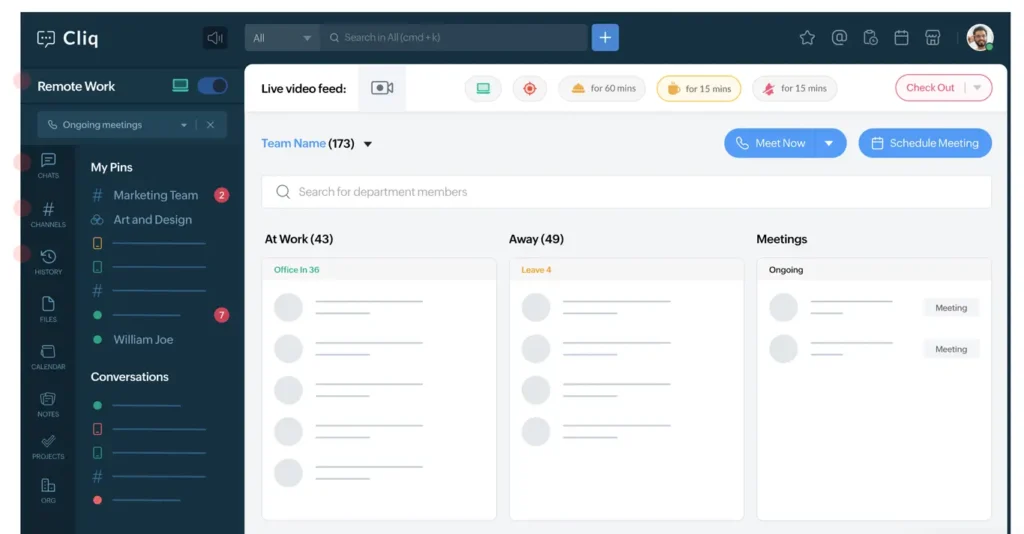
On the other hand, Slack has gained popularity, especially during and directly after the pandemic, and has established itself as a household name in team communication. Most of Slack's appeal lies in its versatility and adaptability. It offers a broad range of integrations with third-party applications, including Google Workspace, Microsoft Office 365, and more. However, it lacks the native integrations that Cliq boasts.
Slack’s user-friendly interface is versatile enough to accommodate both small teams and large enterprises with channels, direct messages, and threads allowing for dynamic and scalable conversations.
While Slack offers a wide range of features and app integrations, it comes at a higher price point, particularly for teams needing unlimited message history or advanced security features. This has led many businesses to consider alternatives like Zoho Cliq, which offers similar functionality at a lower cost, making it an attractive option for budget-conscious teams.

While Zoho Cliq benefits from an integrated ecosystem when paired with Zoho apps, many focused on business growth and communication, Slack stands its ground with a larger pool of outsider integration capabilities to over 2,000 apps. If your organization needs extensive customization and is willing to pay for it, Slack’s API and developer tools might be better for you as they offer more tailored solutions.
While both platforms prioritize an intuitive and seamless user experience, Slack has a slightly more polished design and flexibility that can be more appealing to those companies that want more ‘aesthetics’ in their communications. On the other hand, Zoho Cliq offers a far more organized view and focuses on simplifying navigation for those who prioritize functionality over form.
Zoho Cliq is by far the leader of the two with its competitive pricing, which is especially advantageous for organizations already invested in Zoho products. You’ll save money on Cliq and the Zoho environment in general, which means more cost savings the more you bundle. Slack, meanwhile, offers a free tier with limited features, but its more comprehensive plans come at a premium.
Security is key no matter what communication platform we are talking about. Cliq boasts a number of features and practices to secure user data, from end-to-end encryption, access control, compliance certifications, audit logs, and more. Slack also uses encryptions and data loss prevention methods but has multiple weaknesses, mainly through its integration with outside apps.

Choosing between Zoho Cliq and Slack really depends on each business’s specific needs. For those already embedded in the Zoho ecosystem and looking for cost-effective, seamless integration, Zoho Cliq is the way to go. Its ability to synchronize efficiently with other Zoho apps can streamline processes, minimize redundancy, and enhance productivity. However, Slack may be the better choice if your organization requires a platform with extensive third-party integrations and prioritizes a flexible, customizable user experience.
Ultimately, both Zoho Cliq and Slack are good team communication platforms, and your decision should align with strategic business goals, resources, and existing technology infrastructure. Whichever path you choose, adopting an effective communication tool is an important step toward fostering collaboration and driving organizational success.
Ready to optimize your team’s communication? Book a free consultation with us today!
When we talk about the must-haves of business nowadays, automating sales processes is going to rank pretty high on any list. There are countless tools and CRM systems right at your fingertips, and they can do everything from simplifying your sales journey to boosting productivity, allowing you to work smarter (not harder) than ever before.
But first, you have to understand how you can automate sales processes in a way that genuinely makes a difference.

When talking about automating your sales process, it is important to choose the right CRM. Some CRMs like Salesforce, HubSpot, and Zoho offer various features to automate different aspects of sales. So, when selecting your CRM, you need to weigh factors like ease of integration with existing sales tools, customization capabilities, and the analytics provided.
Other tools that you can include are systems such as Mailchimp for email marketing, LinkedIn Sales Navigator for prospecting, and Zapier if you want to integrate multiple applications. It might take you a bit, but the right blend of tools will help your sales team reduce their manual efforts and focus on more strategic and necessary tasks.

Now, let’s talk about automating lead management as part of automating sales processes. The first stage of any good sales funnel is capturing and nurturing leads, but that takes up quite a bit of time and effort. Automation tools can streamline lead generation through forms on your website, social media platforms, and targeted ads on various platforms. Plus, implementing automating lead scoring systems can help prioritize prospects, making sure your sales team knows which leads are more promising and should be engaged with first.
Moreover, automating follow-ups via personalized email campaigns is a great way to keep up engagement with those same potential customers. Tools like Mailchimp and ActiveCampaign allow businesses to design tailored strategies for specific audience segments, meaning businesses can nurture leads directly through relevant content that gradually guides them down the sales funnel.

Timely and consistent communication is key to closing sales. Automated responses can acknowledge inquiries or pre-qualify leads, ensuring that prospects feel attended to, even when your team is unavailable. Scheduled emails, chatbots, and social media automation can sustain dialogue with prospects and customers alike.
For instance, utilizing chatbots on your website can provide immediate assistance and gather customer information, freeing up your sales team for more complex interactions. Similarly, a well-structured email sequence can move leads through the funnel, sharing valuable content at critical touchpoints.

As a business owner you already likely know just how much of your sales team’s time is taken up with administrative tasks. Automating data entry and reporting not only saves them time, letting them focus on other aspects of business and bringing in more sales, but it also makes data more accurate.
One example of this is syncing CRM systems with other business applications, which in turn automatically logs interactions and updates client profiles so your team always has the latest info. Additionally, automated reports and dashboards can provide real-time insights into your sales pipeline’s performance. These analytics empower your sales team to make more data-driven decisions, adjust strategies even on the fly, and forecast future sales trends much more accurately.
The final step in automating sales processes is to continually analyze, optimize, and improve. Metrics such as conversion rates and deal velocity should be regularly reviewed to ensure that the approach aligns with business goals and market dynamics.
To make sure that you are optimizing and improving properly, make sure you are getting feedback from your team so you can identify and rectify bottlenecks or inefficiencies. Also, remember to remain open to incorporating new tools or strategies to further enhance performance.

In the end, by tapping into the power of sales automation tools and CRM features, businesses can not only improve efficiency but also unlock greater growth potential through automating sales processes. This approach can transform how your sales team operates, granting them more time to do what they do best: foster meaningful relationships and drive sales. So, what are you waiting for? Get started today and watch your sales process transform into a well-oiled machine that works for your business, not against it. Want to find out how we can help you? Let’s chat.
If you're a small business owner, attracting local customers is key to growing your business, highlighting the importance of SEO. Whether you're running a café, a boutique, or a service provider, you want the people in your area to find you easily and choose you over the competition. That’s where local SEO (Search Engine Optimization) comes in.
Local SEO helps your business appear in online searches when people are looking for products or services nearby. Think of it as making sure your business pops up when someone searches for something “near me” on Google. Here’s why it’s super important for your business and how you can start using it to get noticed.

The main reason to focus on local SEO is to help your business show up higher in search results when people in your area are looking for what you offer. For example, when someone types in “best pizza near me” or “plumber in [your town],” you want your business to be at the top of the list.
If you aren’t optimizing your website or Google Business Profile, you're missing out on potential customers who are actively searching for services like yours. Local SEO helps you get noticed in these searches, which can land you a spot in the Google Map Pack—that highly visible map and business listing that shows up before any regular search results.
According to Google, 76% of people who search for something nearby on their phone visit a business within a day. That’s a huge opportunity! By optimizing for local SEO, you’re making it easier for people to find your business, see your hours, read your reviews, and get directions—all of which make it more likely they’ll visit you in person.
Local SEO literally puts your business on the map for customers ready to stop by and make a purchase.

Showing up consistently in local search results does more than increase visibility—it builds trust. When potential customers see your business listed at the top of their search, along with solid reviews, it signals that you’re a credible and trusted option in the area.
Encouraging happy customers to leave positive reviews is a great way to boost your online reputation with the local community. Over time, this can help you stand out as the go-to business in your area.
We know it can feel tough to compete with larger businesses with bigger marketing budgets, but local SEO gives small businesses an edge. While national companies might dominate broad searches, local SEO helps you shine when it comes to location-specific searches.
For example, while you might not beat a big-box store for “buy tools online,” with the right local SEO strategy, your hardware store can easily rank at the top for “hardware store in [your town].” Local SEO helps you go toe-to-toe with bigger brands, especially when it comes to your specific area.

Now that you know how important local SEO is, let’s talk about how to implement it. Here are some simple steps to help your business get found by local customers:
This is the big one! Make sure you claim your Google Business Profile and fill it out completely. Add all the relevant details, like your business name, address, phone number, website, hours, and services. Make sure everything is accurate and consistent across the web.
Positive reviews can give your local SEO a serious boost. Encourage your happy customers to leave glowing reviews on Google, Yelp, and other platforms. The more high-quality reviews you have, the better you’ll rank.

Incorporate location-specific keywords into your website’s content. For example, instead of just saying “best bakery,” try “best bakery in [your town]” to help Google understand where you’re located and match you with nearby searches.
Many local searches happen on phones, so your website needs to work well on mobile. Make sure it loads quickly, is easy to navigate, and has all your key info (like contact details and hours) right up front.

Try adding a blog or news section to your website that focuses on local events, collaborations, or other community-related topics. This will help you rank better in local searches and build a stronger connection with your audience.
Local SEO is a game changer for small businesses. It helps you get noticed by nearby customers, build trust in your community, and even compete with bigger brands. If you haven’t started working on your local SEO yet, now’s the time! With a little effort, you can attract more customers, drive more foot traffic, and grow your business right in your own neighborhood.
We offer SEO services in collaboration with our partners at Lucent Creative, a female-led digital marketing agency. Need a hand getting your business on the (local) map? Book a free consultation.
If you’re tired of old-school video meetings, this is for you. We’re also going to go out on a limb here and say this is also for the “doodlers” who wrote in their history books back in the day.
Meet Vani by Zoho, the latest innovation that's about to shake up how you work, collaborate, and stay productive. Vani is the platform that will boost your team’s communication and creativity.
Think of it as your new best friend in the digital workspace. It's not just another app—it’s the easiest way for your team to collaborate on an infinite canvas. Team members can express themselves, build on ideas, and get stuff done in real-time–all while hanging out together over a video Catchup.

The biggest standout feature of Vani is total creative and communication freedom! Here’s a peek at how we get your team pumping out their best creative work:
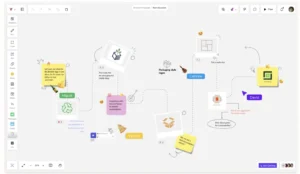
Vani’s impressive features create a “sky’s the limit!” collaborative environment for your team.
Then, there’s the real VIP— Catchups, which bring your team as close as they can get to creating together in person. Everybody can see each other, talk, create, and meet without losing context or having to switch screens. Say goodbye to boring Zoom meetings and screen-sharing. Catchups give your team the advantage of video but pile on the features that make meetings productive.
Review, plan, visualize, and play as a team! You’ll never have an unproductive meeting again. Well, we can’t promise that, but Vani makes it easy to collaborate in a way that makes “boring” a thing of the past.

Do you have a team? Then, it’s for you! Vani is perfect for any industry and its features are versatile for any business size. Marketing and Product Management departments love Vani. Small teams can get started with Vani for free! It’s incredibly affordable for growing agencies, too, at only $4/month when you pay annually. That’s such a great investment for a tool that will boost team collaboration like nobody’s business!

Zoho has done it again; this time, they’ve raised the bar with Vani. If you’re ready to boost your productivity and stay ahead of the curve, it’s time to get on board with Vani by Zoho. This isn’t just a product; it’s a revolution in how your team hits goals in real time.
Don’t just take our word for it—try it for yourself!
Ready to Optimize Daily Operations? Book a free consultation with us today.
Managing a team can be complex, especially when juggling everything from payroll to performance reviews. That’s where Zoho People Plus comes in. It’s an all-in-one HR management platform designed to make your life easier by bringing together all the tools you need to manage your workforce efficiently. Whether you’re running a small business or a large company, Zoho People Plus helps you keep everything organized and running smoothly.

Zoho People Plus is a comprehensive HR management system that combines everything you need in one place. It’s part of the broader Zoho suite, known for its user-friendly design and powerful features. You can handle everything from hiring and onboarding to payroll and employee engagement, all from a single platform.
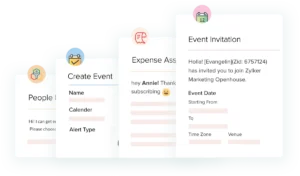
Keeping track of employee details is a breeze. You can store all your employee information in one organized database, making it easy to find what you need, when you need it. Plus, you can customize the fields to fit your company’s specific needs.
Say goodbye to manual time tracking. It offers automated time tracking and attendance management, integrating with biometric devices and mobile apps to ensure accuracy. Whether your team is in the office or working remotely, you’ll always have a clear picture of who’s working when.

Payroll can be a headache, but Zoho People Plus makes it simple. The platform automates salary calculations, tax deductions, and other payroll tasks, helping you avoid errors and stay compliant with local regulations. And with direct deposit support, payday is easier for everyone.
Hiring the right people is crucial, and this platform makes it easier than ever. Manage job postings, track applicants, and evaluate candidates all within the platform. Once you’ve made a hire, it streamlines the onboarding process, helping new employees get up to speed quickly.
Keeping track of employee performance is key to helping your team grow. Zoho People Plus offers tools for setting goals, giving feedback, and conducting performance reviews. With a clear performance management system, you can ensure that everyone is aligned and working toward the same objectives.
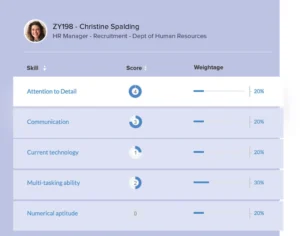
Zoho People Plus includes a self-service portal where employees can handle their own HR tasks, like updating personal info, requesting time off, and viewing payslips. This not only saves time for your HR team but also gives employees more control over their own work life.
Continuous learning is essential for keeping your team engaged and up-to-date. Zoho People Plus includes a learning management system (LMS) that allows you to create and manage training programs, track progress, and assess outcomes, ensuring your team is always learning and growing.
A happy, engaged team is a productive team. Zoho People Plus offers tools to run surveys, manage recognition programs, and foster better communication and collaboration within your team. These features help create a positive work environment where employees feel valued and motivated.
Zoho People Plus stands out because it’s flexible, scalable, and easy to use. It’s designed to adapt to your company’s unique needs, whether you’re managing a small team or a large, distributed workforce. And since it’s part of the Zoho suite, it integrates seamlessly with other Zoho apps, making it a powerful tool for building a cohesive business ecosystem.
Plus, because it’s cloud-based, Zoho People Plus keeps your HR data secure and accessible from anywhere. The mobile app also lets managers and employees handle HR tasks on the go, providing the flexibility that modern businesses need.

Zoho People Plus is more than just an HR tool—it’s a complete solution for managing every aspect of your employee lifecycle. By automating routine tasks, improving engagement, and providing valuable insights, Zoho People Plus allows you to focus on what really matters: helping your team succeed.
Whether you’re looking to streamline your HR processes, boost employee satisfaction, or support your team’s growth, Zoho People Plus has you covered.
See other ways Zoho can boost your HR Department:
Seamless communication and collaboration are essential for productivity and success.
Enter Zoho Cliq, a powerful team communication tool designed to streamline interactions, enhance collaboration, and boost efficiency. Let’s explore how Zoho Cliq can transform your workplace and create a more connected and productive work environment.

Zoho Cliq facilitates real-time team communication through instant messaging, allowing team members to stay connected and share information quickly. This immediate exchange of ideas and updates reduces delays and ensures that everyone is on the same page. Whether it's a quick question or a critical update, Zoho Cliq ensures that your team can respond promptly.

One of the standout features of Zoho Cliq is its use of channels. Channels are dedicated spaces for specific topics, projects, or teams. By organizing conversations into channels, Zoho Cliq helps prevent information overload and keeps discussions focused. Team members can join channels relevant to their work, ensuring they receive pertinent information without unnecessary distractions.
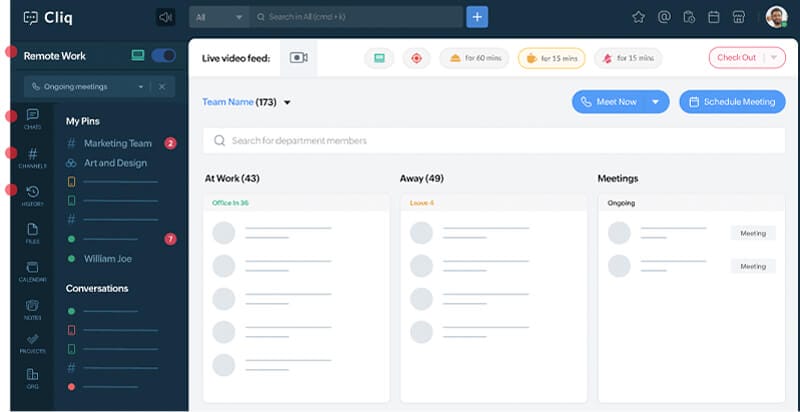
Zoho Cliq seamlessly integrates with various third-party applications and Zoho's suite of products. This integration capability allows teams to access and share information from different tools within a single platform. Whether it's pulling data from your CRM, sharing files from cloud storage, or scheduling meetings, Zoho Cliq's integrations enhance efficiency by reducing the need to switch between multiple applications.
Explore how you can migrate from Microsoft Teams to Zoho Cliq for enhanced collaboration here.
Collaboration is at the heart of Zoho Cliq’s functionality. The platform supports file sharing, enabling team members to share documents, images, and other files directly within the chat. Additionally, Zoho Cliq offers built-in video conferencing, making it easy to conduct virtual meetings, brainstorming sessions, and presentations. With its user-friendly interface and robust feature set, Zoho Cliq simplifies the complexities of modern workplace communication, making it an indispensable tool for teams striving for seamless collaboration. These features ensure that teams can collaborate effectively, regardless of their physical location.
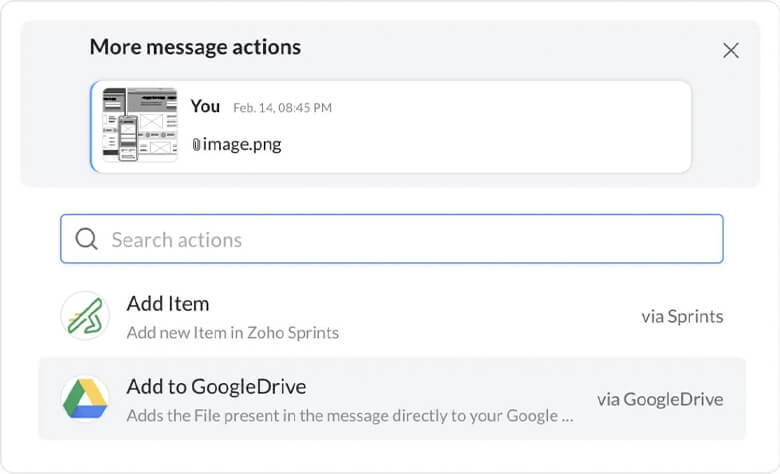
Zoho Cliq offers extensive customization options through its bots and commands. Bots can be programmed to automate routine tasks, such as sending reminders, tracking project progress, or fetching data from other applications. Commands allow users to perform specific actions directly within the chat interface, streamlining workflows and saving time. This level of customization and automation helps teams work smarter, not harder.
In an era of remote work and on-the-go professionals, mobile accessibility is crucial. Zoho Cliq’s mobile app ensures that team members can stay connected and productive no matter where they are. The mobile app offers the same robust features as the desktop version, including instant messaging, file sharing, and video conferencing, ensuring that work doesn't come to a halt when team members are away from their desks.

Zoho Cliq enhances transparency and accountability within teams. The platform's messaging history and searchable chat logs allow team members to revisit past conversations, decisions, and shared files. This transparency ensures that everyone has access to the information they need and helps prevent misunderstandings. Additionally, the ability to track project updates and milestones within Zoho Cliq fosters accountability and keeps everyone aligned with their goals.
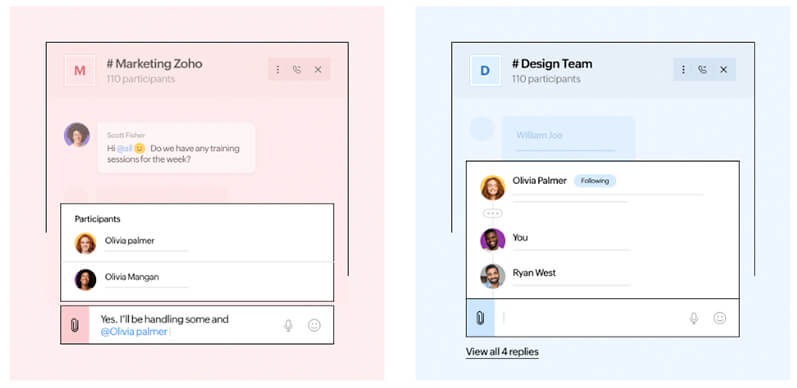
Zoho Cliq is more than just a messaging app; it’s a comprehensive communication and collaboration tool that can significantly improve the workplace. By facilitating real-time communication, organizing conversations, integrating with other tools, enhancing collaboration, offering customization and automation, ensuring mobile accessibility, and promoting transparency and accountability, Zoho Cliq empowers teams to work more efficiently and effectively.
Get started with Zoho Cliq and transform your workplace into a hub of productivity and innovation.
Having a customer relationship management (CRM) system that adapts to your unique needs is a game-changer.
Enter Zoho Canvas, a revolutionary feature within the Zoho CRM ecosystem that empowers users to design and customize their CRM interface to reflect their business's specific workflows and aesthetic preferences. This blog post will delve into what Zoho Canvas is, its benefits, and how it can transform your CRM experience.

Zoho Canvas is a drag-and-drop interface design tool that allows users to create custom views for their CRM data. Unlike traditional CRM interfaces that can feel rigid and one-size-fits-all, Zoho Canvas offers a high degree of flexibility, enabling businesses to tailor the look and feel of their CRM to better align with their processes and branding.
With Zoho Canvas, you are not just limited to the standard layouts provided by your CRM. You can design a user interface (UI) that suits your specific needs, whether that means creating a minimalist view for quick data entry or a detailed layout that provides comprehensive customer insights at a glance.
Drag-and-Drop Interface: The intuitive drag-and-drop functionality of Zoho Canvas makes it accessible to users of all technical backgrounds. You don’t need to know how to code to create a beautiful and functional interface.
Custom Views: Create custom views that cater to different departments within your organization. For instance, your sales team might need a detailed view of client interactions, while your support team might benefit from a streamlined ticket management layout.
Rich Text Formatting: Enhance your data presentation with rich text formatting options. This feature allows you to use various fonts, colors, and styles to highlight important information and improve readability.
Custom Components: Add custom components such as images, buttons, and widgets to your CRM interface. These elements can help you create a more engaging and user-friendly experience.
Conditional Formatting: Use conditional formatting to automatically change the appearance of data fields based on specific criteria. This can help you quickly identify important information, such as overdue tasks or high-value leads.
Reusable Templates: Save time by creating reusable templates for common layouts. These templates can be applied across different modules, ensuring a consistent look and feel throughout your CRM.

Enhanced Usability: By customizing your CRM interface, you can create a more intuitive and user-friendly experience. This can lead to increased adoption rates among your team and improved overall efficiency.
Improved Data Visualization: Zoho Canvas allows you to present your data in a way that makes sense for your business. Custom views and conditional formatting help ensure that important information is easily accessible and visually appealing.
Tailored Workflow: Different teams within your organization have different needs. Zoho Canvas enables you to create interfaces that align with each team’s specific workflows, improving productivity and reducing friction.
Brand Consistency: A customized CRM interface can help reinforce your brand identity. By incorporating your company’s colors, logos, and design elements, you can create a cohesive experience that aligns with your overall branding strategy.
Scalability: As your business grows and evolves, so too can your CRM interface. Zoho Canvas makes it easy to adjust and expand your layouts to accommodate new processes, teams, and data sources.
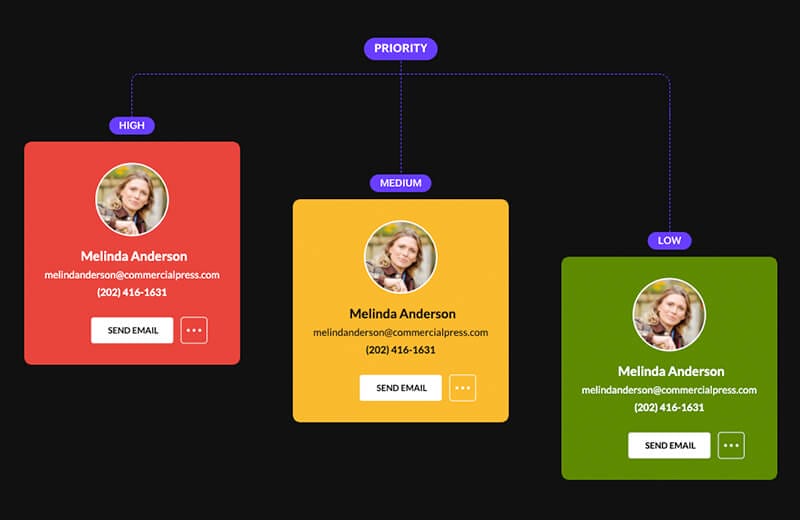
1. Accessing Zoho Canvas: To begin using Zoho Canvas, log in to your Zoho CRM account. Navigate to the module you want to customize and select the “Canvas” option from the view settings.
2. Designing Your Layout: Use the drag-and-drop editor to design your custom layout. Add fields, components, and formatting as needed to create a view that suits your business requirements.
3. Preview and Publish: Once you’re satisfied with your design, preview it to ensure everything looks and functions as expected. Make any necessary adjustments, then publish your layout for your team to use.
4. Training and Adoption: Introduce your team to the new interface and provide training to help them get the most out of the customized views. Encourage feedback and be prepared to make further tweaks based on their input.
5. Ongoing Optimization: Regularly review and update your CRM layouts to ensure they continue to meet your business needs. Zoho Canvas makes it easy to iterate and improve your designs over time.
Imagine a sales team that needs quick access to lead information while on the go. With Zoho Canvas, you can create a mobile-friendly view that prioritizes key data fields and includes action buttons for common tasks like calling or emailing leads. Alternatively, a customer support team might benefit from a detailed ticket view that includes customer history, priority levels, and resolution times, all designed to streamline the support process.

Zoho Canvas is a powerful tool that transforms how businesses interact with their CRM data. By offering customization options, it enables organizations to create interfaces that enhance usability, improve data visualization, and align with unique workflows. Whether you’re looking to increase team efficiency, maintain brand consistency, or scale your operations, Zoho Canvas provides the flexibility and functionality you need to take your CRM to the next level.
Do you need a hand with implementation? Chat with our team about the best solutions for your business.
Thinking about making the switch from Microsoft Teams to Zoho Cliq?
Great choice!
Zoho Cliq is a fantastic platform for team collaboration, offering a streamlined, user-friendly experience that can take your productivity to the next level. If you're ready to make the move but aren’t sure where to start, we’ve got you covered. Let’s dive into the benefits of Zoho Cliq and guide you through the migration process in a few easy steps.

Before we get into the nitty-gritty of migration, let’s talk about why Zoho Cliq is a brilliant choice:
Intuitive Interface: Zoho Cliq’s clean, straightforward interface is easy to navigate, allowing you to focus on what really matters—collaborating with your team.
Customizable Workflows: With Cliq, you can tailor workflows to suit your specific needs. It integrates seamlessly with other Zoho apps and third-party tools, providing a cohesive work environment.
Real-Time Messaging and Collaboration: Enjoy robust messaging features, including channels, direct messages, and even video calls, all designed to keep your team connected and productive.
Enhanced Security: Zoho Cliq strongly emphasizes security, ensuring that your communications are encrypted and your data is protected.
Cost-Effective: Zoho Cliq offers excellent value for money, making it a budget-friendly option without compromising quality.
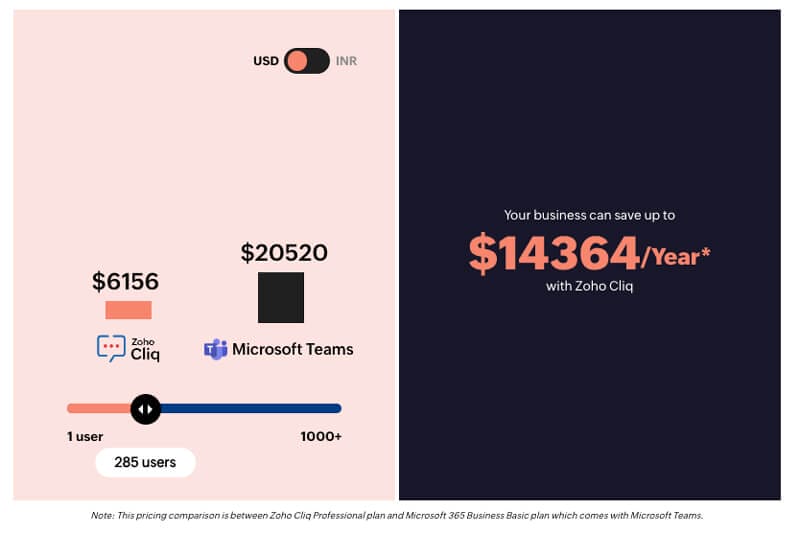
Now that you’re sold on the benefits, let’s walk through the migration process.
Start by taking stock of your current Microsoft Teams setup. Identify your channels, groups, and users and any important data or files stored within the platform. This will help you plan your migration and ensure nothing gets left behind.
Communication is key! Inform your team about the upcoming change and provide them with an overview of Zoho Cliq’s features. Encourage them to explore the platform and offer training sessions or resources to help them get up to speed.
Sign up for Zoho Cliq if you haven’t already. Once your account is set up, create channels and groups that mirror your existing Microsoft Teams structure. This will make the transition smoother for everyone involved.

Export your important data from Microsoft Teams. This can include chat histories, files, and user lists. Microsoft provides tools and options for exporting this data, which can typically be found in the admin settings.
Use Zoho Cliq’s import features to bring your data into the new platform. You may need to manually upload files and copy over chat histories, but the intuitive interface makes this process relatively painless.
Zoho Cliq integrates seamlessly with a variety of other tools, including the rest of the Zoho suite and popular third-party apps. Set up these integrations to ensure your workflows remain uninterrupted and your team has access to all the tools they need.

Once everything is set up, spend some time testing Zoho Cliq with your team. Make sure all channels, groups, and integrations are working as expected. Gather feedback from your team and make any necessary adjustments to optimize the platform for your specific needs.
Provide ongoing support and training for your team as they get accustomed to Zoho Cliq. Utilize Zoho’s help resources, tutorials, and customer support to address any questions or issues that arise.

Read more about how to easily integrate Zoho with other cloud services.
Making the switch to Zoho Cliq isn’t just about changing platforms; it’s about enhancing your team’s collaboration and productivity. With its user-friendly interface, customizable workflows, and seamless integrations, Zoho Cliq offers a more streamlined and efficient way to communicate and collaborate. Plus, with its cost-effective pricing, you get top-notch features without breaking the bank.

So, if you’re ready to make the move, follow these steps, and you’ll enjoy Zoho Cliq's benefits in no time. If you’re new to Zoho, welcome! Their products are superior and they’re an amazing company with outstanding humanitarian efforts.
Get started with Zoho Cliq here. As Zoho Partners, our team of experts is here to help your team seamlessly move to Zoho platforms. Get in touch!
Our friends at Lucent Creative, a woman-owned digital marketing agency, have a few tips for navigating marketing in 2024.
New year, new approach–it’s time to sharpen our content planning game. The days of throwing spaghetti at the wall and hoping it sticks are long gone. In this era of information overload, strategic content planning is the secret sauce for cutting through the noise and capturing your audience's attention.
So, grab your coffee, and let's embark on a journey into the future of content planning.

In 2024, it's all about understanding your audience on a personal level. Consumers are craving content that speaks directly to their needs, preferences, and pain points. Start by diving deep into your audience personas – who are they, what keeps them up at night, and how does your content make their lives better?
Leverage data analytics and social listening tools to gain insights into your audience's behavior. What are they clicking on? What are they sharing? Understanding your audience's digital footprint is key to creating content that resonates. Personalization is the name of the game, and the more you know about your audience, the better you can tailor your content to meet their expectations.
Bonus! Master your social media campaign with this blog post.
Static content is no longer enough; your audience wants to be a part of the experience. From quizzes and polls to interactive infographics and 360-degree videos, the possibilities are endless. Interactive content keeps your audience engaged and invested in your brand.
Make interactive elements a priority in your 2024 content calendar. Host live Q&A sessions, create polls on social media to gather opinions, etc. The more you can involve your audience in the content creation process, the more connected they'll feel to your brand.

In the age of information overload, quality trumps quantity. In 2024, it's not about bombarding your audience with a constant stream of content. It’s about creating meaningful, high-quality pieces that add value. Invest time in researching and producing well-crafted content that solves problems, educates, or entertains. Whether it's a blog post, video, or podcast episode, make it worth your audience's time. Consumers are looking for substance and authenticity.
If video content wasn't at the top of your content planning list before, it should be now. Video content is no longer optional; it's essential for capturing and retaining audience attention. Whether it's short-form content for social media or long-form storytelling on YouTube, video is the medium of choice for many consumers.
Incorporate a variety of video formats into your content strategy. Think about how-to videos, behind-the-scenes glimpses, customer testimonials, and even interactive live streams. Video not only allows you to convey information more dynamically but also helps humanize your brand and establish a deeper connection with your audience.

Bonus! Read about optimizing your blog with video in 2024 here.
Search Engine Optimization (SEO) is still a crucial element of content planning in 2024. The way people search may evolve, but the importance of being discoverable on search engines remains. Keep a keen eye on emerging SEO trends, such as the rise of voice search and the continued emphasis on user experience.
Craft content with relevant keywords, but prioritize natural language and readability. Google's algorithms are getting smarter, and they're favoring content that provides a good user experience. Focus on creating content that answers questions, solves problems, and keeps users engaged – this will naturally boost your SEO rankings.
Artificial Intelligence (AI) isn't just for sci-fi movies; it's a game-changer in the world of content planning. AI can analyze data, predict trends, and even suggest optimizations for your content strategy.
Explore AI-powered tools for content creation, such as automated writing assistance or image recognition for visual content. AI can help you understand what content is resonating with your audience, predict future trends, and optimize your content strategy for maximum impact. It's like having a digital ally that guides you through the ever-evolving landscape of content creation.

From understanding your audience on a personal level to embracing interactive and high-quality content, the rules of the game are evolving. Video is king, SEO is still relevant, and the power of AI and UGC is undeniable. So, roll up your sleeves, stay agile, and embark on your content odyssey armed with the trends that will shape the narrative in 2024.
Need a hand with content in 2024? Get in touch with Lucent Creative’s team of marketing professionals.
Emails still rank at the top of the charts in marketing and are crazy-successful if you execute them correctly.
Even with new social media platforms bursting onto the scene at what seems to be daily, a good old-fashioned email campaign still performs the best. Here are a few stats from HubSpot showing just how big of a punch emails throw at the competing platforms.
These stats are proof that you have a willingly captive audience that your organization only needs to tap into.
So, how do you create an email marketing campaign that engages your audience, generates new leads, and increases revenue? Don’t worry. We reached out to our partners at Lucent Creative, a female-owned digital marketing agency, and they agreed to give you the exact formula for a wildly successful email marketing campaign!

“Casting a wide net with your email campaign isn’t the key to success. You want to be specific by setting an overall goal for each campaign.”, Lucent Creative’s Founder and CEO, Kendall Walker shares.
Here are a few examples of goals you can associate with your email campaigns:
Lucent Creative’s copywriter, Nikki Newbauer, spoke to the value of setting specific goals. “Knowing your overarching goal for the email campaign will create synchronicity for your creative team. Everyone from your copywriter to graphic designer will be on the same page which creates a clear and concise path for your readers to follow.”
Below are the general categories most email campaigns fall under.
The more specific you are with the intention of your email campaign, the more success you will have in reaching your intended audience and reaching your goal.

“Readers will either opt-in by opening your email or deleting based on the subject line. Of course, you always hope your content will be enticing enough that email subscribers will open every email from your brand, but that isn’t the case.”, Nikki added.
Pro Tip: Spruce up your email subject lines with emojis and by using the subscriber’s first name.
Here are great subject lines to stir some engagement with your emails.

Of course, you want your writing to reflect the underlying goal of the email, but nothing gets people to unsubscribe from your email list faster than impersonal content. Write for humans, not sales (or whatever your email campaign endgame is). “If you choose to use AI platforms like ChatGPT to generate your email copy, please edit with a heavy hand. AI platforms may be able to churn out copy on a whim, but the writing is typically riddled with impersonal verbiage that isn’t relatable to readers.”, Nikki stresses.
Deep-Dive: To see more of our take on ChatGPT in marketing, read this post.
Nikki gave us a few tips to follow to make your email campaign a success.
Test your emails to see what your subscribers are engaging with. Knowing how your emails are performing is vital to your email campaign’s longevity. Use an email campaign platform that allows deep-dive analytics through A/B testing. Testing your emails is an entire science in and of itself so research how to set your platform to do the hardest work for your team.

Remember, your email campaign won’t be perfect. Use analytics to learn and adjust accordingly. Emails are a great way to build rapport with leads and build brand awareness. Follow these tips and let us know how your future email campaign goes!
Please do us a favor. Reach out and let us know if you’re finding these marketing posts useful in your business. Have a suggestion? Let us know!